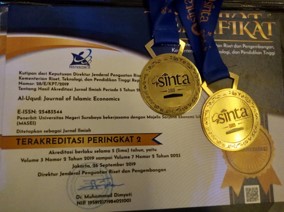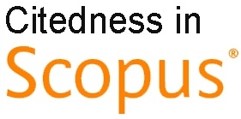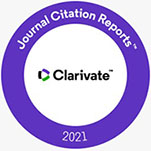Psychosocial Strains and Default Behavior in Islamic Fintech: An Urban-Rural GST Perspective
Keywords:
Economic pressure, Default intention, Social difficulties, Islamic Microfinance Institution, Urban, Rural areasAbstract
This study explores the psychosocial drivers of loan default among Millennials and Gen Z users of Islamic fintech microfinance in Indonesia, using General Strain Theory (GST) to compare urban and rural contexts. Data from 307 respondents were analyzed using Structural Equation Modeling–Partial Least Squares (SEM-PLS). The findings reveal significant differences: in urban areas, default intention is shaped by social difficulties, inferiority feelings, life dissatisfaction, loneliness, and weakened moral norms, while in rural settings, loneliness is the sole significant factor. Economic pressure was not a dominant predictor, highlighting the greater role of psychosocial strain. These insights suggest that fintech companies should enhance credit risk models by integrating social and psychological indicators. Interventions such as financial literacy, moral education, and community-based support are crucial, especially for rural users facing social isolation. The study contributes a novel integration of GST within the context of Islamic fintech, offering both theoretical depth and practical guidance for inclusive and ethical fintech development.
References
A. Basha, S., Elgammal, M.M. and Abuzayed, B.M. (2021), “Online peer-to-peer lending: A review of the literature”, Electronic Commerce Research and Applications, Elsevier B.V., College of Business and Economics, Qatar University, Doha, Qatar, Vol. 48, doi: 10.1016/j.elerap.2021.101069.
Agnew, R. (1992), “Foundations for a General Strains Theory of Crime and Delinquency”, Criminology, Vol. 30 No. 1, pp. 47–87.
Al-Housani, M.I., Koç, M. and Al-Sada, M.S. (2023), “Investigations on Entrepreneurship Needs, Challenges, and Models for Countries in Transition to Sustainable Development from Resource-Based Economy—Qatar as a Case”, Sustainability (Switzerland), Vol. 15 No. 9, doi: 10.3390/su15097537.
Aprilia, Z. (2024), “OJK: Fintech P2P yang Belum Turunkan Bunga Pinjaman Sisa Satu”, CNBC Indonesia, available at: https://www.cnbcindonesia.com/market/20240123150900-17-508339/ojk-fintech-p2p-yang-belum-turunkan-bunga-pinjaman-sisa-satu (accessed 24 January 2024).
Asebedo, S.D. and Wilmarth, M.J. (2017), “Does how we feel about financial strain matter for mental health?”, Journal of Financial Therapy, Vol. 8 No. 1, pp. 63–78, doi: 10.4148/1944-9771.1130.
Badra, S. and Vichore, S. (2024), “Fintech and fi nancial inclusion : conceptual foundations and research landscape”, Global Knowledge, Memory and Communication, Vol. article in No. article in press, p. article in press, doi: 10.1108/GKMC-07-2024-0443.
Bakri, M.H., Abdul Aziz, N.A., Md Razak, M.I., Abdul Hamid, M.H., Md Nor, M.Z. and Iskandar Mirza, A.A. (2023), “Acceptance Of Ddkoin Blockchain Using Utaut Model: A Customer Perspective Approach”, Quality - Access to Success, SRAC - Romanian Society for Quality, Faculty of Technology Management and Technopreneurship, Universiti Teknikal Malaysia Melaka, Malaysia, Vol. 24 No. 192, pp. 103–121, doi: 10.47750/QAS/24.192.13.
Chin, W.W. (1998), “The partial least squares approach for structural equation modeling.”, Modern Methods for Business Research., Lawrence Erlbaum Associates Publishers, Mahwah, NJ, US, pp. 295–336.
Chin, W.W. (2010), Handbook of Partial Least Squares, Handbook of Partial Least Squares, doi: 10.1007/978-3-540-32827-8.
Ding, J., Huang, J., Li, Y. and Meng, M. (2019), “Is there an effective reputation mechanism in peer-to-peer lending? Evidence from China”, Finance Research Letters, Elsevier Ltd, School of Finance, Collaborative Innovation Center of Scientific Finance & Industry, Guangdong University of Finance and Economics, Guangzhou, 510320, China, Vol. 30, pp. 208–215, doi: 10.1016/j.frl.2018.09.015.
Donnellan, M.B., Trzesniewski, K.H., Robins, R.W., Moffitt, T.E. and Caspi, A. (2005), “Low Self-Esteem is Related to Aggression, Antisocial Behavior, and Delinquency”, Psychological Science, Vol. 16 No. 4, pp. 328–335.
Ettman, C.K., Fan, A.Y., Philips, A.P., Adam, G.P., Ringlein, G., Clark, M.A., Wilson, I.B., et al. (2023), “Financial strain and depression in the U.S.: a scoping review”, Translational Psychiatry, Springer US, Vol. 13 No. 1, doi: 10.1038/s41398-023-02460-z.
Ferdianto, A. (2024), “OJK Catat Ada 19 Pinjol Punya Kredit Macet di Atas 5%”, Keuangan Kontan, available at: https://keuangan.kontan.co.id/news/ojk-catat-ada-19-pinjol-punya-kredit-macet-di-atas-5 (accessed 24 January 2024).
Ferrante, J. (1992), Sociology: A Global Perspective, First Edit., Wadsworth Publishing Company, Belmont, CA.
Gaganis, C., Papadimitri, P., Pasiouras, F. and Tasiou, M. (2023), “Social traits and credit card default: a two-stage prediction framework”, Annals of Operations Research, Springer US, Vol. 325 No. 2, pp. 1231–1253, doi: 10.1007/s10479-022-04859-1.
Ghozali, I. (2011), Aplikasi Analisis Multivariate Dengan IMB SPSS 19, Badan Penerbit Undip, Semarang.
Hair Jr., J.H., Black, W.C., Babin, B.J. and Anderson, R.E. (2014), Multivariate Data Analysis (Seventh Edition), Hampshire, SP10 5BE, United Kingdom.
Hair Jr., J.H., Black, W.C., Babin, B.J. and Anderson, R.E. (2019), Eighth Edition Multivariate Data Analysis, 8th ed., Annabel Ainscow, Cherlton House, North Way, Andover, Hampshire, United Kingdom.
Hay, C. and Meldrum, R. (2010), “Bullying Victimization and Adolescent Self-harm: Testing Hypotheses from General Strain Theory”, Journal of Youth and Adolescence, Vol. 39 No. 5, pp. 446–459.
Henseler, J., Hubona, G. and Ray, P.A. (2016), “Using PLS path modeling in new technology research: Updated guidelines”, Industrial Management and Data Systems, Emerald Group Publishing Ltd., Vol. 116 No. 1, pp. 2–20, doi: 10.1108/IMDS-09-2015-0382.
Henseler, J., Ringle, C.M. and Sarstedt, M. (2015), “A new criterion for assessing discriminant validity in variance-based structural equation modeling”, Journal of the Academy of Marketing Science, Vol. 43 No. 1, pp. 115–135, doi: 10.1007/s11747-014-0403-8.
Hinduja, S. (2007), “Work Place Violence and Negative Affective Responses: a Test of Agnew’s General Strain Theory”, Journal of Criminal Justice, Vol. 35 No. 6, pp. 657–666.
Huang, J. and Fang, Y. (2021), “Income inequality, neighbourhood social capital and subjective well-being in china: Exploration of a moderating effect”, International Journal of Environmental Research and Public Health, Vol. 18 No. 13, doi: 10.3390/ijerph18136799.
Huang, W., Shen, J. and Yuan, C. (2022), “How Decent Work Affects Affective Commitment Among Chinese Employees: The Roles of Psychological Safety and Labor Relations Climate”, Journal of Career Assessment, SAGE Publications Inc., Shenzhen Audencia Business School, Shenzhen University, China, Vol. 30 No. 1, pp. 157–180, doi: 10.1177/10690727211029673.
Hulland, J. (1999), “Use of Partial Least Squares (PLS) in Strategic Management Research: A Review of Four Recent Studies”, Strategic Management Journal, Wiley, Vol. 20 No. 2, pp. 195–204.
Indonesia, A. (2019), Pedoman Perilaku Pemberian Layanan Pinjam Meminjam Uang Berbasis Teknologi Informasi Secara Bertanggung Jawab.
Ivantri, M.A., Azizi, M.H., Yudha, A.T.R.C. and Saputra, Y. (2024), “Gold-based housing financing model: proposing an alternative housing financing model for Islamic bank”, Journal of Islamic Accounting and Business Research, Emerald Publishing Limited, Vol. ahead-of-p No. ahead-of-print, doi: 10.1108/JIABR-12-2023-0414.
Kasmon, B., Ibrahim, S.S., Daud, D., Raja Hisham, R.R.I. and Dian Wisika Prajanti, S. (2024), “FinTech application in Islamic social finance in Asia region: a systematic literature review”, International Journal of Ethics and Systems, Vol. article in No. article in press, p. article in press, doi: 10.1108/IJOES-07-2023-0155.
Leiber, M.J., Mack, K.Y. and Featherstone, R.A. (2009), “Family Structure, Family Processes, Economic Factors, And Delinquency: Similarities And Differences by Race And Ethnicity”, Youth Violence and Juvenile Justice, Vol. 7 No. 2, pp. 79–99.
Liang, F., Yu-Thompson, Y. and Lu-Andrews, R. (2016), “Liquidity and corporate governance: Evidence from family firms”, Review of Accounting and Finance, Vol. 15 No. 2, pp. 144–173, doi: 10.1108/RAF-03-2015-0039.
Lin, M.F. (2009), “Peer-to-Peer Lending: an Empirical Study”, Proceedings of the AMCIS 2009 Doctoral Consortium in San Francisco, San Fransisco, United States of America, pp. 1–7.
Lu, T., Jia, Z., Xu, Y., Huang, L. and Zhang, C. (2016), Psychosocial Factors Lead to Delinquency Itention on Online Peer-To-Peer Lending Platform: A Survey Evidence.
Mahmud, K., Joarder, M.M.A. and Sakib, K. (2023), “Customer Fintech Readiness (CFR): Assessing customer readiness for fintech in Bangladesh”, Journal of Open Innovation: Technology, Market, and Complexity, Elsevier, Vol. 9 No. 2, p. 100032, doi: 10.1016/j.joitmc.2023.100032.
Morris, R.G., Carriaga, M.L., Diamond, B., Piquero, N.L. and Piquero, A.R. (2012), “Does Prison Strain Lead to Prison Misbehavior? An Application of General Strain Theory to Inmate Misconduct”, Journal of Criminal Justice, Vol. 40 No. 3, pp. 194–201.
Niu, B., Ren, J. and Li, X. (2019), “Credit scoring using machine learning by combing social network information: Evidence from peer-to-peer lending”, Information (Switzerland), MDPI AG, Vol. 10 No. 12, doi: 10.3390/INFO10120397.
Nurfadilah, D., Nurhaida, D. and Samidi, S. (2022a), “The Default In Islamic Peer to Peer Lending: an Application of The General Strain Theory”, Journal of Islamic Monetary Economics and Finance, Bank Indonesia Institute, Vol. 8 No. 2, pp. 219–250, doi: 10.21098/jimf.v8i2.1432.
Nurfadilah, D., Nurhaida, D. and Samidi, S. (2022b), “the Default in Islamic Peer To Peer Lending: an Application of the General Strain Theory”, Journal of Islamic Monetary Economics and Finance, Vol. 8 No. 2, pp. 219–250, doi: 10.21098/jimf.v8i2.1432.
Nurfadilah, D. and Samidi, S. (2021), “How the Covid-19 Crisis Is Affecting Customers’ Intention To Use Islamic Fintech Services: Evidence From Indonesia”, Journal of Islamic Monetary Economics and Finance, Vol. 7 No. 1, pp. 83–114, doi: 10.21098/jimf.v7i0.1318.
OJK. (2023), “Financial Technology - P2P Lending”, IKNB - Financial Technology, available at: https://ojk.go.id/id/kanal/iknb/financial-technology/default.aspx.
Opoku, R.A. and Adom, P.K. (2023), “Energy literacy levels and energy investment choices of faith-based organisations in Accra Metropolitan Assembly, Ghana: Implications for energy conservation”, Cleaner and Responsible Consumption, Elsevier Ltd, Vol. 8, doi: 10.1016/j.clrc.2023.100100.
Otoritas Jasa Keuangan. (2021), Penyelenggara Fintech Lending Terdaftar Dan Berizin Di OJK per 6 April 2021.
Otoritas Jasa Keuangan RI. (2023a), Statistik IKNB Syariah, Jakarta.
Otoritas Jasa Keuangan RI. (2023b), Peraturan Otoritas Jasa Keuangan Republik Indonesia No. 3 Tahun 2023 Tentang Peningkatan Literasi Dan Inklusi Keuangan Di Sektor Jasa Keuangan Bagi Konsumen Dan Masyarakat Indonesia, Peraturan Otoritas Jasa Keuangan, Vol. 53, pp. 3–5.
Piquero, N.L., Fox, K., Piquero, A.R., Capowich, G. and Mazerolle, P. (2010), “Gender, General Strain Theory, Negative Emotions, and Disordered Eating”, Journal of Youth and Adolescence, Vol. 39 No. 4, pp. 380–392.
Puspadini, M. (2023), “Utang Pinjol Naik 14% Jadi Rp 55,7 T, Terbanyak Untuk Ini...”, CNBC Indonesia, available at: https://www.cnbcindonesia.com/market/20231103111445-17-486105/utang-pinjol-naik-14-jadi-rp-557-t-terbanyak-untuk-ini (accessed 27 April 2024).
Rest, J., Narvaez, D., Thoma, S.J. and Bebeau, M.J. (1999), “DIT-2: Devising and testing a new instrument of moral judgement”, Journal of Educational Psychology, Vol. 91 No. 4, pp. 644–659.
Risdiana, D.M. and Susanto, T.D. (2019), “The safe city: Conceptual model development - A systematic literature review”, Procedia Computer Science, Vol. 161, Elsevier B.V., pp. 291–299, doi: 10.1016/j.procs.2019.11.126.
Rufrancos, H., Power, M., Pickett, K.E. and Wilkinson. (2013), “Income Inequality and Crime: a Review And Explanation of the Time-Series Evidence”, Sociology and Criminology, Vol. 1 No. 1, p. 103.
Santoso, W., Trinugroho, I. and Risfandy, T. (2020), “What Determine Loan Rate and Default Status in Financial Technology Online Direct Lending? Evidence from Indonesia”, Emerging Markets Finance and Trade, Routledge, Vol. 56 No. 2, pp. 351–369, doi: 10.1080/1540496X.2019.1605595.
Saputra, F. (2024a), “Sejumlah Fintech P2P Lending Dihadapkan Masalah Kredit Macet yang Membengkak”, Keuangan Kontan, available at: https://keuangan.kontan.co.id/news/sejumlah-fintech-p2p-lending-dihadapkan-permasalahan-kredit-macet-yang-membengkak (accessed 24 January 2024).
Saputra, F. (2024b), “Masalah Gagal Bayar Bikin Lender Investree Tak Minat Taruh Dana Lagi”, Keuangan Kontan, available at: https://keuangan.kontan.co.id/news/masalah-gagal-bayar-bikin-lender-investree-tak-minat-taruh-dana-lagi (accessed 24 January 2024).
Singh, K. (2024), “Economics and financial sustainability in microfinancing: do investment flows toward developing countries, rural areas, microenterprises and female borrowers foster institutionalization?”, Studies in Economics and Finance, doi: 10.1108/SEF-08-2024-0474.
SKOPI, K. (2024), “Apakah Financial Technology (Fintech) Sama dengan Pinjaman Online?”, Kementerian Koperasi Dan UMKM, available at: https://skopi.kemenkopukm.go.id/blog/2#:~:text=Namun%2C pinjol sebenarnya merupakan bagian,tidak terdaftar dan berizin OJK. (accessed 26 January 2024).
Ssekiziyivu, B., Mwesigwa, R., Joseph, M. and Nkote Nabeta, I. (2017), “Credit allocation, risk management and loan portfolio performance of MFIs—A case of Ugandan firms”, Cogent Business and Management, Cogent, Vol. 4 No. 1, pp. 1–13, doi: 10.1080/23311975.2017.1374921.
Subagyo, A., Syari’udin, A. and Yunani, A. (2023), “Determinant residential real estate of millennial generation in adapting housing microfinance case Indonesia chapter”, International Journal of Housing Markets and Analysis, Vol. 16 No. 5, pp. 1007–1020, doi: 10.1108/IJHMA-04-2022-0063.
Suryono, R.R., Budi, I. and Purwandari, B. (2021), “Detection of fintech P2P lending issues in Indonesia”, Heliyon, Elsevier Ltd, Vol. 7 No. 4, p. e06782, doi: 10.1016/j.heliyon.2021.e06782.
Tegambwage, A.G. and Kasoga, P.S. (2022), “Loan repayment among group borrowers in Tanzania: the role of relationship quality”, Future Business Journal, Springer Berlin Heidelberg, Vol. 8 No. 1, pp. 1–11, doi: 10.1186/s43093-022-00151-7.
Tully, S.M. and Sharma, E. (2022), “Consumer wealth”, Consumer Psychology Review, Vol. 5 No. 1, pp. 125–143, doi: 10.1002/arcp.1073.
Untari, P.H. (2023), “OJK Catat Masih Ada 20 Pinjol dengan TWP90 di Atas 50%”, Finansial Bisnis, available at: https://finansial.bisnis.com/read/20231101/563/1710250/ojk-catat-masih-ada-20-pinjol-dengan-twp90-di-atas-5 (accessed 24 January 2024).
Wang, X., Xu, Y.C., Lu, T. and Zhang, C. (2020), “Why do borrowers default on online loans? An inquiry of their psychology mechanism”, Internet Research, Emerald Group Holdings Ltd., Vol. 30 No. 4, pp. 1203–1228, doi: 10.1108/INTR-05-2019-0183.
Wibowo, B. (2016), “Analisa regulasi fintech dalam membangun perekonomian di indonesia”, Jurnal Magister Teknik Elektro Universitas Mercu Buana, pp. 1–9.
Wiedmann, K.-P. and von Mettenheim, W. (2020), “Attractiveness, trustworthiness and expertise – social influencers’ winning formula?”, Journal of Product and Brand Management, Emerald Group Holdings Ltd., Institute of Marketing and Management, Leibniz University of Hannover, Hannover, Germany, Vol. 30 No. 5, pp. 707–725, doi: 10.1108/JPBM-06-2019-2442.
Wu, G. and Peng, Q. (2024), “Bridging the Digital Divide: Unraveling the Determinants of FinTech Adoption in Rural Communities”, SAGE Open, Vol. 14 No. 1, pp. 1–16, doi: 10.1177/21582440241227770.
Yasih, D.W.P., Putri, N.R. and Prasetyo, I. (2024), “Godaan Pinjol bagi Pengemudi Ojol”, Koran Tempo, available at: https://koran.tempo.co/read/urban/486562/pengemudi-ojol-rentan-pinjol (accessed 24 January 2024).
Yudha, A.T.R.C., Amiruddin, A.R., Hilmi, A.F., Kaffah, A.F., Fauzi, F.N., Evarianti, I., Maghfiroh, L., et al. (2020), Fintech Syariah: Teori Dan Terapan, Edisi Perd., Scopindo Media Pustaka, Surabaya.
Yudha, A.T.R.C., Huda, N., Maksum, M., Sherawali, S. and Wijayanti, I. (2024), “The Moderating Effect of Religiosity on Fashion Uniqueness and Consciousness in Halal Fashion Purchase”, Indonesian Journal of Halal Research; Vol 6, No 2 (2024): AugustDO - 10.15575/Ijhar.V6i2.34614 .
Yudha, A.T.R.C., Zidna, R.R. and Febriyanti, N. (2024), “Exploring a Consumption Value Model for Halal Cosmetics”, Etikonomi, Vol. 23 No. 2, pp. 465–480, doi: https://doi.org/10.15408/etk.v23i2.36080.
Zainudin, M.I., Haji Hasan, F. and Othman, A.K. (2020), “Halal brand personality and brand loyalty among millennial modest fashion consumers in Malaysia”, Journal of Islamic Marketing, Emerald Group Holdings Ltd., Vol. 11 No. 6, pp. 1277–1293, doi: 10.1108/JIMA-10-2018-0187.
Zhao, H. and Zhang, L. (2020), “Talking money at home: the value of family financial socialization”, International Journal of Bank Marketing, Emerald Group Holdings Ltd., School of Finance and Business, Shanghai Normal University, Shanghai, China, Vol. 38 No. 7, pp. 1617–1634, doi: 10.1108/IJBM-04-2020-0174.
Zustika, A.F. and Yudha, A.T.R.C. (2020), “Peer to Peer Lending System in Hifdul Maal Perspective: Evidence From he Fintech Company of Investree”, Jurnal Ekonomi Syariah Teori Dan Terapan, Vol. 7 No. 8, pp. 1585–1597, doi: 10.20473/vol7iss20208pp1584-1597.
Published
How to Cite
Issue
Section
License

This work is licensed under a Creative Commons Attribution 4.0 International License.
CC BY 4.0 Abstract views: 0
Abstract views: 0







